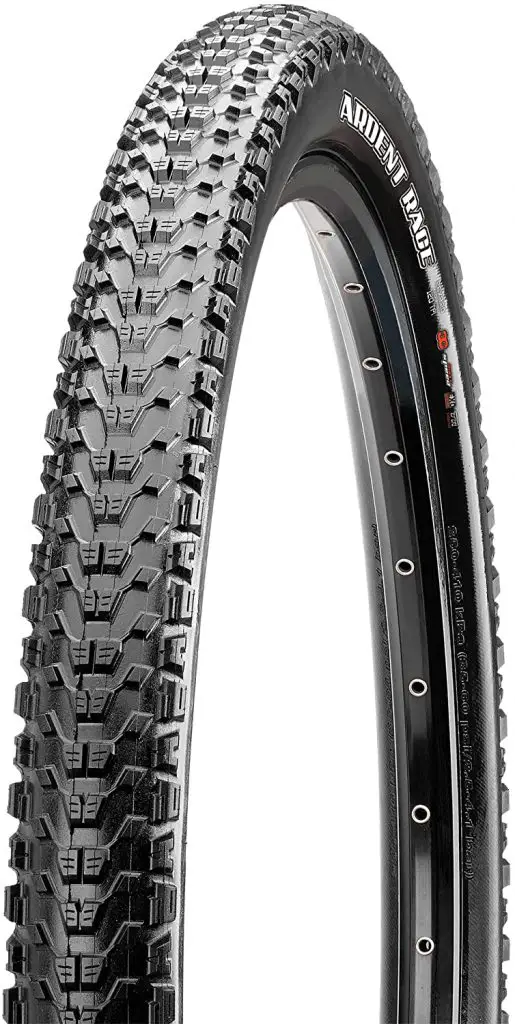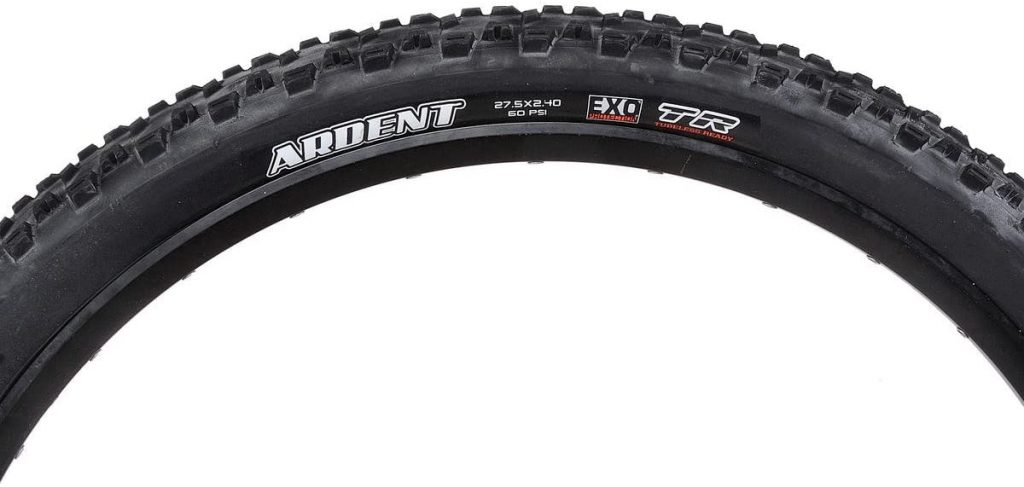The Maxxis Ardent is something of a do-it-all trail tire that’s had relatively high success rates and popularity with mountain cyclists for a while now. It’s designed to handle a wide variety of terrains and trail styles without slowing the rider or offering a lot of rolling resistance. That said, the tread is only moderately aggressive, and it looks like less of an all-terrain all-condition tire than many of its competitors.
Our review is really focused on the performance of the tire and how it stacks up to similar offerings that are designed for a similar kind of trail ride. We’ll look at where the Ardent stands out, where it falls a little short, and the differences between front and rear mounting this tire. Plus, we’ll cover some of what you can expect once you’re actually out on the trail.
Things to Consider Before Buying Bike Tire

Maxxis Ardent is one of the biggest names for mountain bike tires right now. Great for XC trails and with a new tread and tire profile every few seasons, they’ve cornered the market on creating a durable line of high-performance for price mountain bike tires.
That brand reputation should definitely be considered when you’re looking for a great tire since it comes with better assurances that the tire has actually been built to do what it says it can do.
However, a tire like the Ardent that’s less specialized and more of a generalist on the trail is also going to fall short of more specialized tires in their performance specialties.
That doesn’t make the Ardent a worse tire, it just means that if you tend to ride loose terrain, are a particularly aggressive rider, or like coming into a corner just a little too hot, you may want to consider a tire that specializes in your riding style and conditions.
That being said, the Ardent tests well as both a front-mounted tire and a rear-mounted tire. Put in back and its durability and ability to take a hit really shine. In front, this tire gives you a lot of float and very little rolling resistance for a faster kind of ride.
The Ardent is also somewhere in the middle of wider profile tires. It doesn’t have the aggressive squared-off profile some cornering tires prefer, but it’s more rounded shape also doesn’t have any dead zones or major loss of reactivity and grip. It’s not as wide as some trail tires, but also offers significantly less roll resistance than wider, grippier, tread designs.
As a do it all tire, you can’t expect the Ardent to be a perfect performer, but it’s well suited to moderately aggressive cyclists who don’t mind checking trail conditions before they head out for a ride.
Features & Benefits
Overall Durability
Maxxis ArdentDurability is one of the areas that the Ardent really shines. That’s not a huge surprise since Maxxis is well known for producing high quality and durable tire sets.
The tread on the Ardent resists degrading. The outer tread tends to pit and show some signs of wear and tear after several months of regular use, especially if you tend to ride harsh surfaces and other difficult terrains.
However, the large outer tread still performs just as well with moderate and even severe pitting, and the rubber doesn’t lose reactivity or traction with wear and tear.
The internal, smaller, tread is even more durable. Made from a composite rubber, the light central tread is unlikely to show much wear and tear, even with regular use and difficult terrain.
Ardent tires are also relatively puncture-resistant, and unlikely to give way even on cheese grater rocks and other difficult terrain. They aren’t completely impervious though, and you’ll still likely need a patch if you run over the business end of a nail or screw. Thick branches can be a similar problem if your tire hits them pointy-end first.
The good news is that the Maxxis Ardent takes patching well and will still perform well as a tire for months after applying a good tire patch.
More: The Best Bike Seats for Overweight Cyclists
Tread Design

The tread on the Ardent is a moderately aggressive design neither as aggressive as the best all-terrain mountain tires nor as short as a typical hybrid tire set. The inner tread is relatively short, though still a good bit taller than the tread on a road bike.
That center tread is fantastic for good rolling resistance. That is, there is very little rolling resistance when you’re riding the bike centered. The lightweight design and ramped knobs make this one of the faster models of tire designed for mountain trails.
Rolling downhill or on a straightaway, you’ll notice that it’s a very efficient design, cutting your effort and letting you rest up for the next uphill slope on your trail.
The 2 by 2 tread is also relatively squared off, which works to increase traction between your tire and the terrain. We’ll talk about terrain strengths and weaknesses in a separate section, but it’s worth noting here that this is a good medium between speed and traction.
Center and intermediate treat designs offer moderately good breaking traction, with performance that’s neither the best nor the worst in Maxxis’ line. The design offers the best traction on firm surfaces, with variable results in other conditions.
However, the more aggressive outer tread is great for cornering, offering firm performance and a high degree of responsiveness. Especially mounted as a read tire, the Ardent is just a touch drifty, especially if you like to corner hot, but not so much that you’re likely to lose control of the tire, much less the bike as a whole.
The Ardent supports a moderately aggressive lean, but it takes a little experience to figure out where the limits of the tire really are.
Side Wall Strength
Fortunately, the sidewalls of the Ardent are strong enough to hold up to a few blowouts if you really want to test the limits of the tread. The tires come with EXO protection, which means a few grams of added weight, but significantly better durability.
This is not a tire that you need to worry about blowing the side walls before you’ve squeezed the last life out of the tread, which is saying something when the tread is as long-lasting as the Ardent.
More: The Best Bike Water Bottle On the Market
Installation
Installation of the Ardent is a breeze. The tires can be installed with no tools and a simple floor pump. That said, if you already have the appropriate tools and a pneumatic pump on hand, there’s no reason no to speed the whole process up.
Generally, you won’t have to do a lot of prep work on your rims to make sure they’re Ardent safe. Rim tape and other precautions are optional, though we do recommend using them just to make sure you’re getting the absolute most out of your tires, especially since the industry is trending toward more expensive models and high prices even for average tires.
Performance

As a front, rear, or double tire set, the Ardent is designed for moderately aggressive cyclists who like cornering at speed, but don’t tend to take on trails with particularly loose soil or in highly adverse conditions.
As a rear tire, the Ardent has a lot of floats and can be a little drifty, while it’s more of a speed demon as a front tire.
Terrain Strengths and Weaknesses
The Ardent does well in most conditions and is a particularly fast tire of firm terrain. In light loose soil, it’s nicely responsive and stable. The Ardent is also well balanced for rocky trails, and durable enough to hold up to gravel and even jagged rock.
However, it tends to struggle in thick mud, especially sticky loose mud. The tread isn’t aggressive enough for thick loose soil or sandy conditions, and quickly loses traction in those conditions.
More: The Best Bike Water Bottle Holders
Pros and Cons
Pros
- Exceptionally durable
- A responsive tire with low rolling resistance
- EXO protection
- Works well as a front or rear tire, balanced enough to use on both wheels
- Easy installation
- Good for most mountain trails and moderately aggressive riders
Cons
- Tread does not perform as well in loose soils or mud
- Overall design not as well suited to very aggressive cyclists or the most challenging trails
- Newer tires offer a slightly better balance between grip and rolling resistance
What Other Customer Says
Users are generally very pleased by this tire, especially used in combination with a more aggressive design that offers better grip for added traction and better all-condition performance. Ready to go tubeless, installation is a breeze, and many cyclists report that the high durability of the Ardent makes is a great rear-tire design.
It’s a good combination tire, but most users do note that there are other newer tires in the Maxxis line and others that outperform the Ardent as both a specialist tire and an all-purpose design.
More: The Best Commuter Bike Helmet
Alternatives to Maxxis Ardent
Maxxis Ardent vs Minion
The Minion is a significantly heavier tire than the Ardent, but with that said, there are some definite advantages to the Minion if you’re an especially aggressive rider, or if you tend to ride very rocky trails or trails with loosely packed dirt.
The tread of the Minion is similar in design to the Ardent. However, the tread is significantly thicker on the Minion, which is what gives it better loose soil traction. The center portion of the tread is also noticeably wider, and there isn’t as much of a height difference between in center, intermediate, and outer tread.
That thicker design also provides greater longevity in the Minion. The Ardent offers great traction in the beginning, but the weaknesses of the less aggressive tread design start to show within a few months of regular riding. While Ardent tires are very durable and rolling resistance and reactivity don’t generally change much with wear, they do tend to become more prone to slips and drifting as they age.
The Minion lasts much longer before starting to lose its superior grip. It’s a good option for more aggressive cyclists and those looking to take on the most difficult terrain conditions.
Maxxis Ardent vs Ikon
Both of these tires have a carbon fiber bead and can be ordered with EXO protection for more durable sidewalls. The Ardent is just a touch thicker than the Ikon, 2.4” compared to 2.2”. In fact, these two tires are often paired together as they offer a relatively balanced combined performance.
Both are also tubeless-ready, or TR, so you have the additional option depending on how you’d prefer to ride.
However, the thinner design of the Ikon combines with a less aggressive tread style to create a much looser grip. It’s got a lot of float and drift potential, and very little rolling resistance for added speed. The Ikon is a good option for riders who are looking for a less aggressive kind of trail ride, and who don’t mind a little looseness in their ride.
However, the Ardent is a better performer if you’re looking for a most solid kind of grip in a responsive and speedy tire design.
Maxxis Forekaster vs Ardent
Like the Ardent, the Forekaster is tubless ready. The two tires have a similar width, with only .05 inch different (the Forekaster is the narrower of the two). But while the Ardent is dual-compound rubber in the center tread, the Forekaster is dual compound throughout.
Like the Ardent, the Forekaster offers very little in the way of rolling resistance and is a quiet ride when the tires are centered. There’s also very little tuck under risk with the Forekaster, even with the most aggressive out of saddle pedaling, challenging terrain, or now.
The Forekaster’s slightly more aggressive tread makes it a slightly more stable design for cornering than the Ardent, though both tire designs handle cornering rather well.
However, the tires are again similar in that they tend to have less grip and slip a little more on very loose terrain types. The Forekaster is also slightly more prone to drifting, especially mounted as the rear tire, or with a cyclist who tends to use the rear brake heavily.
This is another tire set that is often used together, but the Forekaster is a slightly looser, slightly faster option that adapts to aggressive riding styles somewhat better than the Ardent. They share similar terrain weaknesses but are also both highly durable options.
More: The Best Cycling Gloves Review
Conclusion
Overall the Maxxis Ardent is still a solid choice of tire, reasonably affordable for its performance, and offering very low roll resistance and good longevity. It’s a good tire for moderately aggressive cyclists, but isn’t a true all-condition tire, trading some grip and stability for a lightweight design and increased speed.
If you’re looking to ride loose and fast, but don’t mind checking on trail conditions and taking care in sandy and muddy areas, the Ardent is a solid option.




